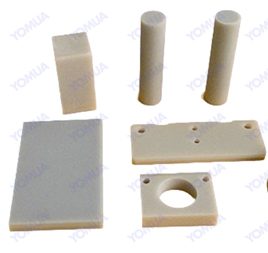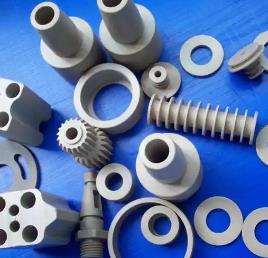Aluminum Nitride (AlN) and polymer-based materials exhibit significant differences in their thermal and mechanical properties due to their distinct chemical structures and bonding characteristics. Here’s a comparison:

Thermal Properties
| Property | AlN | Polymers |
|---|---|---|
| Thermal Conductivity | Very high (170-220 W/m·K) | Very low (0.1-0.5 W/m·K) |
| Thermal Stability | Excellent (stable up to >2000°C) | Poor (degrades at 200-300°C, some high-performance polymers up to 400°C) |
| CTE (Coefficient of Thermal Expansion) | Low (~4.5-5.6 ppm/K, matches well with silicon) | High (50-200 ppm/K, prone to thermal mismatch) |
| Heat Dissipation | Excellent (ideal for heat sinks, substrates) | Poor (used as thermal insulators) |
Mechanical Properties
| Property | AlN | Polymers |
|---|---|---|
| Hardness | Very high (ceramic, brittle) | Low (soft, flexible) |
| Tensile Strength | High (300-400 MPa) | Low to moderate (10-100 MPa) |
| Elastic Modulus | High (~300-330 GPa, stiff) | Low (0.1-10 GPa, flexible) |
| Fracture Toughness | Low (brittle, prone to cracking) | High (tough, impact-resistant) |
| Density | Moderate (~3.26 g/cm³) | Low (0.9-1.5 g/cm³, lightweight) |
| Wear Resistance | Excellent (hard and durable) | Poor to moderate (prone to abrasion) |
Electrical Properties
| Property | AlN | Polymers |
|---|---|---|
| Electrical Conductivity | Insulator (wide bandgap material) | Insulator (most polymers are dielectrics) |
| Dielectric Strength | High (~15-20 kV/mm) | Moderate to high (10-50 kV/mm) |
| Dielectric Constant | Low (~8.5-9.5 at 1 MHz) | Low to moderate (2-5 at 1 MHz) |
| Electrical Insulation | Excellent | Excellent |
Chemical and Environmental Properties
| Property | AlN | Polymers |
|---|---|---|
| Chemical Resistance | Excellent (resists most chemicals) | Varies (some polymers resist chemicals, others degrade) |
| Moisture Absorption | Very low | Moderate to high (hygroscopic in some cases) |
| UV Resistance | Excellent | Poor to moderate (many degrade under UV exposure) |
| Oxidation Resistance | Excellent (stable in air up to 1300°C) | Poor (most oxidize or degrade at high temperatures) |
Processing and Manufacturing
| Property | AlN | Polymers |
|---|---|---|
| Ease of Fabrication | Difficult (requires high-temperature sintering) | Easy (moldable, extrudable, 3D printable) |
| Cost | High (raw material and processing costs) | Low to moderate (cost-effective for mass production) |
| Machinability | Poor (hard and brittle) | Good (easy to cut, shape, and machine) |
| Joining/Welding | Difficult (requires specialized techniques) | Easy (can be welded, bonded, or glued) |
Applications

| Application Area | AlN | Polymers |
|---|---|---|
| Electronics | Heat sinks, substrates, LED packaging | Insulation, encapsulation, flexible circuits |
| Thermal Management | High-performance heat spreaders, thermal interface materials | Thermal insulators, low-heat applications |
| Structural | Limited (brittle, used in specialized cases) | Widely used (lightweight structures, composites) |
| Consumer Goods | Rare (due to cost and brittleness) | Common (packaging, toys, household items) |
| Aerospace/Automotive | High-temperature components | Lightweight parts, interiors, seals |
Advantages and Disadvantages
| Material | Advantages | Disadvantages |
|---|---|---|
| AlN | – High thermal conductivity | – Brittle and prone to cracking |
| – Excellent thermal stability | – Expensive to produce | |
| – High mechanical strength | – Difficult to machine and process | |
| – Good electrical insulation | – Heavy compared to polymers | |
| Polymers | – Lightweight and flexible | – Poor thermal conductivity |
| – Easy to process and manufacture | – Low thermal stability | |
| – Cost-effective | – Low mechanical strength | |
| – Impact-resistant | – Prone to UV and chemical degradation |
Summary
- AlN excels in high thermal conductivity, thermal stability, and mechanical strength, making it ideal for demanding applications like electronics, aerospace, and high-temperature environments. However, it is brittle, expensive, and difficult to process.
- Polymers are lightweight, flexible, and cost-effective, making them suitable for consumer goods, insulation, and structural applications. However, they have poor thermal properties and lower mechanical strength.
The choice between AlN and polymers depends on the specific requirements of the application, such as thermal management, mechanical performance, cost, and ease of fabrication. Let me know if you need further clarification!